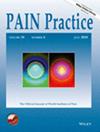Low‐energy differential target multiplexed SCS derivative reduces pain and improves quality of life through 12 months in patients with chronic back and/or leg pain
IF 2.7
3区 医学
Q2 ANESTHESIOLOGY
引用次数: 0
Abstract
IntroductionEnergy‐reducing spinal cord stimulation (SCS) approaches have the potential to impact patient experience with rechargeable and non‐rechargeable SCS devices through reducing device recharge time or enhancing device longevity. This prospective, multi‐center study evaluated the safety, effectiveness, and actual energy usage of differential target multiplexed (DTM) endurance therapy, a reduced energy DTM SCS derivative.MethodsSubjects who reported an overall pain visual analog score (VAS) of ≥6/10 cm and an Oswestry Disability Index score of 21–80 out of 100 at baseline with moderate to severe chronic, intractable back and/or leg pain were eligible. Evaluation visits occurred at 1, 3, 6, and 12 months post‐device activation. The primary objective was to characterize change in overall pain intensity, as measured by VAS, from baseline to 3‐month visit.ResultsFifty‐seven subjects enrolled at 12 US sites from November 2020 through June 2021, 35 were implanted with a rechargeable SCS device, and 27 completed the 12‐month visit. Subjects experienced a 50.4% mean reduction in overall pain from baseline at the 3‐month follow‐up that was sustained through 12 months. Additional outcomes including changes in overall, back, and leg pain intensity, quality of life, disability, therapy satisfaction, safety, and current battery usage are shown through 12‐month follow‐up.ConclusionThe use of DTM endurance SCS therapy in this study resulted in reductions in pain relief through 12 months, demonstrating that energy‐reducing stimulation patterns can provide clinical benefit. Clinically effective, reduced energy SCS derivatives have the potential to impact patient experience through either reduced recharge requirements or increased device longevity.低能量差分靶向多路复用体外脊髓刺激疗法衍生物可在 12 个月内减轻慢性背痛和/或腿痛患者的疼痛并改善其生活质量
导言减少能量的脊髓刺激(SCS)方法有可能通过减少设备充电时间或延长设备寿命来影响患者使用可充电和不可充电 SCS 设备的体验。这项前瞻性多中心研究评估了差分靶向多路复用(DTM)耐力疗法(一种降低能量的 DTM SCS 衍生物)的安全性、有效性和实际能量使用情况。方法基线时报告总体疼痛视觉模拟评分(VAS)≥6/10 厘米、Oswestry 残疾指数评分(满分 100 分,21-80 分)为中度至重度慢性顽固性背部和/或腿部疼痛的受试者均符合条件。评估访问在设备激活后的 1、3、6 和 12 个月进行。结果2020 年 11 月至 2021 年 6 月期间,57 名受试者在美国的 12 个地点注册,35 名受试者植入了可充电 SCS 装置,27 名受试者完成了 12 个月的访问。在 3 个月的随访中,受试者的总体疼痛平均比基线减轻了 50.4%,并持续了 12 个月。其他结果包括总体、背部和腿部疼痛强度、生活质量、残疾程度、治疗满意度、安全性和当前电池使用情况的变化,这些结果都显示在 12 个月的随访中。临床有效的减能量 SCS 衍生物有可能通过降低充电要求或延长设备寿命来影响患者的体验。
本文章由计算机程序翻译,如有差异,请以英文原文为准。
求助全文
约1分钟内获得全文
求助全文
来源期刊

Pain Practice
ANESTHESIOLOGY-CLINICAL NEUROLOGY
CiteScore
5.60
自引率
3.80%
发文量
92
审稿时长
6-12 weeks
期刊介绍:
Pain Practice, the official journal of the World Institute of Pain, publishes international multidisciplinary articles on pain and analgesia that provide its readership with up-to-date research, evaluation methods, and techniques for pain management. Special sections including the Consultant’s Corner, Images in Pain Practice, Case Studies from Mayo, Tutorials, and the Evidence-Based Medicine combine to give pain researchers, pain clinicians and pain fellows in training a systematic approach to continuing education in pain medicine. Prior to publication, all articles and reviews undergo peer review by at least two experts in the field.
 求助内容:
求助内容: 应助结果提醒方式:
应助结果提醒方式:


